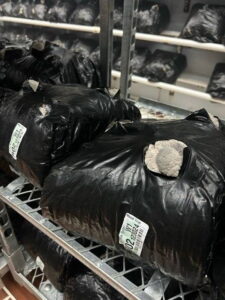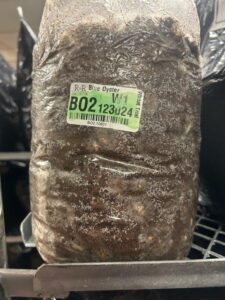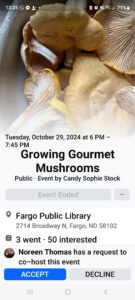Final report for FNC24-1439
Project Information
Melany Thomas- farms in the Red River Valley. She is a beginning, minority, woman farmer growing organic grains, hay, and soybeans. She is interested in niche grains and sells directly to chefs, food hubs, and food for Native American Chefs, and works with other emerging farmers to provide scratch grains for livestock and poultry. She also works with breweries like Bang and Junkyard for adjunct grains ( one of the outcomes of a SARE grant.) She co-organizes a group of 6 other women-owned sustainable farmers under 30. Melany will grow, harvest, clean the grains and ship to R and R Cultivation.
Nick Robinson- is a beginning urban farmer growing mushrooms and co-owner of R and R Cultivation in the heart of New Hope, Mn. The huge two-story warehouse was converted to the largest specialty mushroom farm in the US, growing 12 kinds of mushrooms, all certified organic. R and R cultivation sells mushrooms and growing bags across the US. Nick loves to figure out new processes and wants to work with more regional farmers rather than ship in substrates from faraway places or places that source their grains out of the country. During COVID-19, he realized how fragile the system was and decided to work directly with farmers rather than relying on long distance truckers. His initial buying of rye from Noreen and Melany helped stabilize production and expectations. " The quality of the grains here has been one that has helped us. I want to do a deeper dive into combination and variety differences, which this grant would give us a boost to do. " Nick will coordinate the testing of grains for mushroom production in a lab setting at R and R cultivation.
Noreen Thomas- a woman farmer in the Red River Valley. She grows niche grains, fruits, and rare native American seeds for the White Earth Tribe for preservation. Noreen found a niche in selling oat groats and various combinations that helped other women farmers market and package together. She intends to fill a need for chefs who develop their own mixtures of grains, and she has found success in developing combos of grains and foods. She serves as an advisor for emerging and immigrant farmers. Noreen will coordinate with R and R cultivation and chefs who will test mushrooms for any flavor differences ( good or bad) when switching to other grains.
Specialty mushrooms are a small but growing segment of the mushroom industry and suitable for small producers. Most specialty mushrooms are being grown in white millet, rye and soybean hulls. White millet is grown in Colorado or imported during droughts. We want to test grains like winter wheat, oats, buckwheat, and yellow millet that can be locally grown. Replacing grains or materials like soybean hulls with buckwheat allows regional farmers to raise niche grains for direct markets. Most grains pass through at least five hands before the end users. The old handbook on mushroom growing has not been updated, nor has any research been done on other grains. When Noreen's son started growing mushrooms over 14 years ago, he found success in growing on various grains, which made us ask if we could use other grains. The possibility of using low-protein winter wheat, buckwheat, oats, and yellow millet will help us diversify our grain production by adding new markets, and we can use cover crops such as winter wheat. We will also monitor the flavor as no one knows how different grains affect mushroom flavors. We will grow oyster mushrooms, because it is fast-growing and used in culinary meal preparation.
In 2024, we were successful in growing and using millet. After many tests, the millet showed that Minnesota Grown could be used to grow mushrooms instead of importing millet or sending it from a third-party buyer/seller in Colorado. This grant shortened the supply chain, reduced the overall cost, and gave farmers more market share. Another breakthrough was that the millet previously used was always dehulled, removing the outer layer. With many tests, the millet was tested for quantity, quality, fruiting body, and production hull versus dehulled millet. The testing resulted in the same production as the hulled. This helped reduce the cost of sending the millet to be delivered both to the location for dehulling and then being sent back to to the farm and later sent out to R and R Cultivation. This also decreased the miles the millet was transported to be processed and increased the market to Minnesota growers. We are now testing buckwheat and winter wheat.
Solution- We will compare the productivity of yellow millet, buckwheat and winter wheat as certified organic mushroom growing substrates. The grains will be grown, combined, and cleaned at Doubting Thomas Farm in Moorhead, Minnesota and shipped to R and R cultivation in New Hope, Minnesota. The grains will be sterilized and then inoculated with spores of oyster mushrooms. We chose oyster mushrooms because they are fast-growing and can go from spores to mushrooms in 2-3 weeks. We will record the fruiting times and total production for each grain and repeated the experiment several times. The mushrooms will be sent to a chef in Fargo and one in Minneapolis who will evaluate the quality of mushrooms grown on different grains. After testing individual grains, combinations of grains will be tested, and the "recipe" will be written down. The test will be repeated using combinations of our grains and looking at the mushroom color, poundage produced, and the timing of fruiting. From there, more combinations and trials will evolve out of the first tests. We will make adjustments to the grain mixes as we receive data from the early test results and repeat the procedure. We will use an Excel sheet to compare grains and grain combinations. By comparing the weight of mushrooms produced on different grain substrates, we will start to calculate a cost of production, and we will know which grain substrate will be the most profitable. Grower bags will be prepared and have testing involving growers testing the for fruiting and production. The chefs will determine any flavor difference in-kind. All the work will be combined, and decisions will be made by retesting.
Objectives
- Determine what grains serve as the best substrate for growing mushrooms
- Determine which combinations of grains provide the best substrates
- Develop specs for farmers wanting to grow grains for the market
- Figure out baseline pricing to the mushroom grower and fair to the farmer
- Figure out best practices for shipping organic grains while keeping integrity in place
- Help stabilize the cost of grain by being a regional farmer, then outsource to large companies
- Pictures as well as notes, will be collected on the way for other growers and mushroom growers
- Share findings with others at the winter conference or research poster board
- Share findings through on-site tours, presentations, conferences, and field days.
- Gather info on flavor of mushrooms good or bad, when switching grains from chefs. ( Andrea Baumgartner and Sean Sherman)
Cooperators
- - Producer
- - Producer
- - Producer
Research
The old mushroom handbooks say to use unhulled millet. This is not the case. Have farmers near you grow mushrooms, and try organic millet. We feel that with the hull on, it works just great. Make sure it is cleaned millet, as lots of "fines" or small particles will cause the growing bags to go moldy quickly. The unconventional sprayed millet may cause growing problems as it adversely affects the mushroom.




The production, yield, time to fruit, quality, and quantity were controlled by lab technicians at the mushroom-growing facility. All were measured against the normal grains used. The breakthrough is that millet could be used as a whole kernel.
Educational & Outreach Activities
Learning Outcomes
Collaborating with the mushroom company, we made significant progress, despite challenges. This growing season was particularly tough—buckwheat failed due to heavy rains and drought, leaving over 20,000 acres in Clay County unplanted. Nevertheless, we moved forward with winter wheat testing and sourced buckwheat from another farmer to continue our trials. We also purchased organic buckwheat to test its suitability for mushroom production. Unfortunately, the results were not favorable as the growth process was too slow for practical production.
In addition, we explored the use of finely ground millet particles for mushroom cultivation. Although this wasn’t part of the original grant, we wanted to expand our research. Millet was ground to a flour-like consistency, but in side-by-side comparisons, the small particles molded within 24 hours, rendering them unsuitable. We also tested millet that had not been thoroughly cleaned post-harvest, but this, too, resulted in moldy growing bags, which could contaminate the entire process. Mold remains a significant challenge in mushroom cultivation. That said, millet remains a valuable rotational crop for the Midwest, where Colorado has historically dominated its production and market.
We were excited that using the unhulled millet saved significantly on time and energy. We didn't have to load it, transport it far away to get it dehulled, and then transport it back. Also, if we're hulling, a lot of the millet goes to waste. whereas we're utilizing the whole millet so it's less waste and higher profit for the farmer.
On the positive side, winter wheat successfully colonizes blue oyster mushrooms. This is a major breakthrough, providing a reliable alternative. As a backup, we can also utilize Minnesota-grown winter wheat, which has a lower protein and is harder to market. Winter wheat also provides an effective cover crop, as they can be planted in the fall, emerge early in the spring, and be harvested by midsummer. This reduces field passes and workload while naturally suppressing weeds.
Additionally, soybean hulls have shown great promise as a substrate. While collecting soybean hulls post-harvest can be challenging, they offer excellent potential as a value-added component. Barley, particularly in its malted form, was good for growing gourmet mushrooms. Straight barley without malting did not work very well.
In addition, culinary differences were not noted with the difference in the substrates. (But the question is if mushrooms are gluten-free or if they contain gluten, which exists as a side note.)
The shipping is best done in plastic totes. Make sure moisture is 12% or less. The shipping is best without rain events or snow as the totes will gather moisture and create the possibility of insects being attracted or hatching. Marking totes as food grade and double wrapping them are necessary to make sure that totes stay safe from breaking and contamination in organic. Mark with lot numbers on totes and paperwork for traceability.
Project Outcomes
Melany was able to grow millet. It is much more tolerant of weather than we thought. She learned to plant, grow, cultivate, and harvest. It is not usually grown in NW Minnesota, and she also found it versatile for bird feed ( we have chickens). Emerging farmers are interested in millet since their diet includes millet. Her clean-out ( after cleaning the grain) is used for backyard poultry, so there is zero waste.
grain combination that works for making flour, Native American foraging
